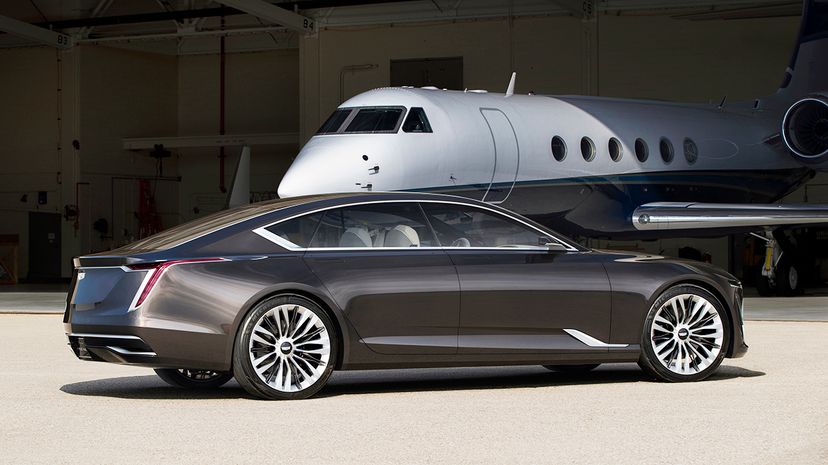
In August 2016, Cadillac unveiled its luxury concept vehicle the Escala in Pebble Beach, California. The car was then featured in Cadillac commercials during the February 2017 Oscars. The commercials were so successful, people actually went to Cadillac dealerships to buy the Escala, only to discover that it was not for sale.
But why not? Because at the time the Escala was only a concept car, one in broad terms, that is designed to showcase a new vision or direction for a brand. And the truth is, few concept cars ever achieve as high of a profile as the Escala received. Typically once a concept car makes the circuit of the year's auto shows, they tend to wither into obscurity.
Advertisement
However, some do get a second lease on life and end up in the hands of private collectors who specifically seek out concept cars and other one-of-a-kind vehicles. But the Cadillac Escala is different; those potential buyers wanted (and expected) a full production version of the car, not a one-off collector's item.
According to Andres Valbuena, the purpose of a concept car is to "think big and get the money to do it." Valbuena spent 20 years working in product development and brand strategy roles for Volkswagen, Jeep and Chevrolet, and has seen many concept vehicles through from aspirational beginnings to humble endings. He now runs a car research website.
"You're always looking five, six years out at what type of vehicles you should bring to market," Valbuena says. "You're doing all this forecasting on what could potentially be hot, SUVs, coupes, whatever it is. You always have this long-term plan, and once one of those long-term plans on paper makes sense, and there's a potential business case for it, then you'll start on the process of actually getting into the details of that specific project."
Here's what the design process looks like:
- The concept car is planned and designed by the automaker's various teams
- The concept car is modeled by computer
- Clay models are made, usually a small display and another to scale
- The automaker holds research clinics with the concept car to get feedback from consumers
- An actual car may be built, though just complete enough for auto show purposes (that is, often not drivable)
- The concept car makes the rounds at the auto show to generate publicity
"If you look at just the display ones, like at the auto shows, those really crazy cars out there ... a lot of times, even though it looks like a car, underneath, sometimes it's not," Valbuena explains. "It's just a square frame with a little electric motor that turns one wheel, so the guys don't push it. It's interesting and it's funny sometimes when you walk around it and you're like, 'Wow, this is really cool.' Well, sometimes it's made out of clay and it weighs 10,000 pounds [4,535 kilos], but you can't tell."
And, when a concept car's time is up, one of several things can happen to them: They can be displayed in the automaker's offices or production facility, donated to a school for teaching purposes, a fire station for training, dismantled or crushed, or sold.
Valbuena says that concept cars aren't sold very often, in part because of liability and also because it doesn't make business sense. But it does happen from time to time. He says that, in his experience, concept cars that were sold came with complicated contracts that prevented buyers from registering them or even driving them on the street. Even drivable, fully functional concept cars are not built to production standards. Volkswagen, for example, sometimes sold functional, less-extreme concept cars to race teams, simply to avoid crushing them.

There are always exceptions, and in the case of concept cars, those exceptions tend to be older. Ohio car collector Myron Vernis owns several concept and one-of-a-kind vehicles. In early 2016 he acquired a 1976 Honda Lady. The Lady is a concept based on the Honda Civic that was built by Italian coachbuilder Sergio Coggiola for the 1976 Geneva Motor Show.
"It was really kind of accidental," Vernis says. "I like unique, one-off and low production cars, and I also like Japanese cars. This one kind of fit both of those models."
Vernis will disclose only that he has fewer than 100 cars in his collection, enough to be well-versed in the process. He drives all of his cars and says he has never had trouble registering or insuring them, even though some take more persistence than others. He says that collectors' car insurance is the best way to protect a concept or other rare car, and that he is fortunate to have mechanically inclined friends who enjoy the challenge of working on his collection.
"The Japanese manufacturers don't seem to let their concept cars get away," Vernis says. "The Americans crush most of them because of liability but the Japanese manufacturers seem to keep them, so it's rare to have a Japanese concept [car] out in private ownership, which is really what made it interesting to me."
So, yes, it is possible to buy a concept car, but unless you're an experienced collector or otherwise well-connected, it is a rather rare experience. Now, about that Cadillac Escala, Cadillac told us as of now the company has no plans for the car to go into production, so if you had your heart set on driving one, we're sorry to disappoint.
Advertisement
